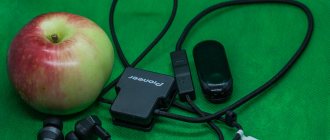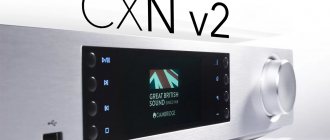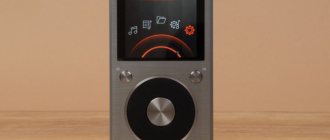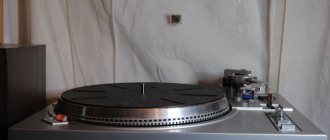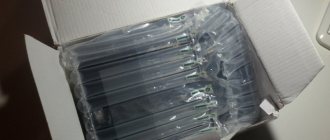Network player-DAC Pioneer N-70AE
I remember the excitement with which we greeted the first CD players. But the spell quickly dissipated. It took more than a decade for digital technology to be able to get rid of long-standing childhood illnesses. History is now repeating itself with network players. Have they already become “adults”? Let's try to answer by meeting top streamer Pioneer.
The evolution of network players, by definition, should be faster, because a very significant technological part of them - digital-to-analog conversion - has already gone through a long and, in my opinion, successful path of development. However, questions arose with network adapters and protocols, and most importantly, with the user interface and the very method of interaction between a person and a network device.
The developers understood that the controls traditional for the computer industry (where network technologies came from) were unacceptable for most users - few would want to listen to music on a stereo system while manipulating the keyboard and mouse. When you relax in the chair, it is, to say the least, uncomfortable. We are used to remote controls, preferably with a minimum number of buttons.
In expensive devices, the problem was solved by using a large touch display (such as Meridian Sooloos or Olive Audio). This technology was already “adult” from birth, but its maturity was very expensive.
Mid-range and budget streamers had to make do with small screens on the front panel and button navigation. And this clearly did not contribute to their popularity. The turning point occurred with the mass distribution of tablets and smartphones—manufacturers were only required to provide the user with a mobile application that turned the “smart” device into a universal remote control. This did not happen right away, the first versions were unstable and buggy, but little by little they solved this problem, and in my opinion the greatest progress was achieved over the past year.
Of course, problems with network technology still remain. But they are no longer characteristic of the type of equipment as such, but of specific devices. This is a consequence of either budget restrictions or a lack of experience among manufacturers who decided to respond to the fashion trend and release a streamer. Usually this not very successful firstborn turns out to be the last. But Pioneer is a different story.
The chassis is reinforced, both power transformers are placed in screens, and the internal space of the case is divided into three parts by steel partitions.
The company made no fuss and released its first streamer only in 2012. Let us recall that network audio players entered the market in 2007, they were created by the British Naim (NaimNet system) and Linn (Klimax DS), but these were exclusive and very expensive devices. Network technology became popular in 2010, although this “popularity” was very relative: the first network audio player that we tested cost $1,800. By the way, our current hero, the Pioneer N-70AE, a flagship already in its second generation and heading a family of five models, is estimated at approximately the same amount (taking into account inflation). The company is very closely involved in this type of equipment; many receivers, microsystems, Pioneer Blu-ray players are also equipped with streaming functions, not to mention the Fayola wireless multiroom line. So there will be no discounts for the manufacturer’s lack of experience in our test.
Plus for ground
In the photo, the N-70AE and N-50AE models are very similar, if you do not pay attention that the body of the first of them is 22 mm higher. But in real life, the older player looks much more solid: it has thick aluminum plates on the sides, the lid is not U-shaped, like the 50th, but flat, and it is secured with six solid screws. Its weight is 4 kg more, not only due to the side pads, but also because the chassis is reinforced, both power transformers are placed in screens, and the internal space of the case is divided into three parts by steel partitions (the 50th has only low metal sidewalls on the sides of the central board).
A headphone amplifier based on the Texas Instruments TPA6120 IC, as well as a significantly improved DAC unit, gave some weight gain. The N-50AE is built on one 8-channel ESS Sabre32 Ultra ES9016S chip, while the N-70AE is built on two, eight channels each in parallel (8ch Parallel Drive). The use of two chips improves the separation between channels and reduces distortion, and this always has a beneficial effect on scene formation. The main boards with the digital path, control modules and LCD display of the two models are completely the same, and the power supplies are almost identical. The only difference in connection is that the N-50AE lacks balanced outputs and a headphone output on the front panel.
The digital path is built on a 32-bit Texas Instruments AM3354 Sitara™ RISC processor with ARM® Cortex®-A8 architecture and DSP on a Texas Instruments D808K013DPTP4 chip. So the hardware is quite powerful, and with normal software it should not slow down.
You can stream music from your smartphone to the streamer from a proprietary mobile application via Wi-Fi.
There are two network interfaces: wired Ethernet and dual-band Wi-Fi 802.11.a/b/g/n/ac. But there is no Bluetooth, and this is easy to understand: the device is solid, made in the classic traditions of Hi-Fi, and it does not need an extra source of interference. In addition, you can stream music from your smartphone to the streamer from a proprietary mobile application via Wi-Fi and with incomparably better quality.
There are two USB connectors for playing files: on the front panel and on the back. It’s convenient to connect flash drives to the first one, and a USB-HDD to the second one; you can upload content to it over the network from a local computer. It must be formatted on the streamer itself, and in the settings you must activate the Network Standby function with power supplied to USB, which will allow you to access the drive over the network at any time, even when the player is in standby mode.
The device can be used as a full-fledged external DAC: it is equipped not only with a USB interface, but also with optical and coaxial inputs and outputs. Next to them on the rear panel there is a 3.5 mm jack (Control Out), it is designed for connection to Pioneer amplifiers and CD players - this will allow you to control them from a mobile application.
The standard remote control looks solid, you won’t even immediately understand what it’s made of - either metal or very dense plastic. There are a lot of buttons, and this is both an advantage and a disadvantage - at first, until you remember where each button is located, you will have to look for the required function. The situation is complicated by dark gray inscriptions, which are very difficult to read on a black background. Although aesthetically this combination is certainly more pleasant than white on black.
It is possible to select the characteristics of the digital filter: SHARP (high slope, default value), SLOW (smooth decay), SHORT (fast impulse response).
The mobile application is much more convenient, more visual and user-friendly, so very soon the standard remote control will remain idle - hide it somewhere so as not to gather dust.
Concluding the conversation about control, I note that the linear output of the N-70AE is fixed and cannot be adjusted. A few years ago I would have considered this correct, since I was convinced of the detrimental effect of digital volume control on sound. But recently the situation has changed: ESS Sabre32 chips have a very high-quality built-in digital level control that does not introduce audible distortion. Moreover, it spoils the sound less than a traditional analog control, even a discrete one. Why is it needed? Then, so that you can connect the player directly to power amplifiers. Sometimes this opportunity comes in very handy.
To the left of the LCD display on the front panel there are three LED indicators. They light up when the corresponding modes and processing are active: DIRECT (complete disabling of DSP), Hi-Bit32 (increasing the signal bit depth before digital-to-analog conversion to 32 bits), Up Sampling (oversampling at 384 kHz). As you know, most delta-sigma DACs work best at maximum input signal parameters - this is precisely the condition that the last two processing provide. Another, Auto Sound Retriever (ASR), synthesizes information lost during lossy encoding - accessed through a dedicated button on the remote and through the SOUND menu. There is also a Lock Range Adjust setting (it also has its own button on the remote control), it changes the range of action of the phase automatic frequency control (PLL) of the reference oscillator in the DAC. The narrower the range, the more effectively jitter is suppressed; the wider, the more tolerant the converter is to the quality of the input signal. If you make the range too narrow, artifacts may appear in the sound - crackling, clicking, signal dropouts. On the N-70AE this adjustment has seven positions, the seventh is set by default, so it’s better to leave it. I note that this configuration functionality is included in many ESS Sabre32 chips, but only Pioneer and Onkyo make it available to users.
Files from a flash drive and over the network play almost indistinguishably.
It is also possible to select the digital filter characteristic: SHARP (high slope, default value), SLOW (smooth roll-off), SHORT (fast impulse response). The choice of these modes is possible only through the menu; they affect the sound very noticeably, and in different ways with streams of different resolutions. The most comfortable and “soft” sound is achieved with the SLOW mode, but when playing Hi-Res material, a more transparent and distinct sound can be obtained with SHORT or even SHARP. In general, don’t be lazy to experiment.
Android
Along the waves of network memory
The procedure for connecting to a network via Wi-Fi is described in detail in the user manual, so I will omit this exciting moment. With Ethernet, everything is quite simple - connect the cable, and you're done. Access to Internet radio and streaming services immediately opens (for those who are not greedy to subscribe). Discovery of resources on the local network occurs quickly - NAS appeared in the menu, but... the player cannot connect to them - the servers deny it access. No surprise: my NAS works with a proprietary version of the DLNA protocol, which is not fully compatible with the standard one. This is not the fault of the player, but of the drives. The issue of compatibility must be taken into account when choosing a NAS. But I created my network infrastructure for digital transport, which works using the SMB protocol, and there are no problems with it.
I had to install a free UPnP MQS server on my home computer - so the N-70AE immediately agreed with it. At the same time, I connect a flash drive with music files to the front USB connector to listen to whether there is a difference in the sound over the network and from local drives. I'm also going to test the device as a DAC, so preparation for listening is completed by installing USB drivers on my home computer - they need to be downloaded from the Pioneer website.
What I especially liked was the harmony - the right balance between resolution and musical expression.
Files from a flash drive and over the network play almost indistinguishably - that’s how it should be. Although some budget network players are different. But the DAC device sounds different - rougher and sharper. The “regular” USB cable is to blame - after replacing it with a higher quality one with double shielding and silver-plated conductors, the sound acquired a pleasant softness, while maintaining high resolution and detail. To obtain complete identical playback over the network and when connecting via USB to an external digital transport, I had to install an iFi iPurifier2 device between the N-70AE and the USB cable. Does this extra cost make sense? I doubt it, because the device plays perfectly over the network. Although the capabilities of computer transport are still wider: you can connect to a NAS via SMB, and also play DSD files packed with the WavPack codec - not a single network streamer understands them. Although I guess that most “normal” music lovers have absolutely no need for all this.
iOS
So how does the N-70AE play?
Plays well. Smooth, precise, clean, comfortable. There is no desire to turn it off after 10 minutes. You can hear the Pioneer “breed”. Sometimes you read on forums that ESS DACs sound too bright and tiring, but this does not apply to our hero. The point is not in the chip, but in its wiring, in the implementation of the converter itself, in the power supply, etc.
What I especially liked was the harmony - the right balance between resolution and musical expressiveness, when everything that is important for the perception of music is heard, but unnecessary information that is not intended for our ears is tactfully hidden. When musical energy and dynamics are adequately conveyed, this is especially evident at live concerts, especially rock ones.
Processing (Hi-Bit32 and Up Sampling) is gentle but noticeable. Especially the first one - the sound seems to become more alive and cheerful. The second manifests itself only on standard definition material - the sound is “smoothed out” and approaches Hi-Res in character. But there is no “taste” of synthetics; it is felt that the processing is carried out with a high bit depth.
All formats that are stated to be supported are played both over the network and via USB. Album covers are displayed if they are integrated into the file, regardless of their size - even 1500 x 1500 pixels are shown without problems and clearly. There are no obvious brakes, only playback starts with some delay - the information is first loaded into the buffer. This is normal, this is how it should be.
The headphone amplifier, although built on an integrated circuit, plays very convincingly. The gain margin is huge, and even with high-impedance models the volume level (it is displayed when adjusted on the display) does not exceed 50%. Accordingly, the bass, energy, and very significant “punch” are in perfect order. The ATH-W1000x's large apertures are kept under complete control and do not take liberties.
Is there really nothing to complain about? Perhaps the only thing is barely noticeable noise (clicks, like when playing vinyl) when playing some 192 kHz/24-bit files, and only at the very beginning. I am sure that this will definitely be fixed - since the release of the model, its software has already been updated three times.
Let's take a look at our archive - this is what was said in the summary of the test of the N-50-K model, which belongs to the first generation of Pioneer streamers:
“Does not play 24-bit/192 kHz files from the front USB connector. Small display. There are no separate menu navigation buttons on the front panel. Adds a pause between tracks. The portable app does not display CD covers."
The current generation models no longer have all these problems. So the childhood of network players, at least for Pioneer, is already behind us.
Pioneer N -70AE
Manufacturer: Pioneer & Onkyo
www.pioneer-audiovisual.eu/ru/def/products/n-70ae
Objective data
Functions: DAC, Network Player (DAR/DAP), Headphone Amplifier || Configuration: stereo || Frequency range (-3 dB), Hz: 4 - 90000 || Harmonic distortion, %: < 0.0017 || Signal-to-noise ratio (A-weighted, RCA/XLR) dB: > 114/117 || DAC: ESS Sabre32 Ultra (ES9016S x2, 384 kHz/32 bit) || Display: color LCD 3.5” || Digital audio formats: PCM up to 24 bit/192 kHz, DSD64/128/256 || Files: AAC, AIF, AIFC, AIFF, APE, FLAC, M4A, M4A (Apple Lossless), ALAC, OGG, WAV, WMA, DSF, DFF || Network services: TIDAL, TuneIn, Spotify, Deezer || Network technologies: AirPlay, Chromecast, DTS Play-Fi, FlareConnect™ || Remote control: IR remote control, mobile applications for iOS/Android || Inputs: - digital: coaxial, optical, USB A/B x3 || Outputs: - analog: balanced (2 x XLR), asymmetrical (2 x RCA) || Service connectors: Control Out (3.5 mm) || Network: Ethernet, Wi-Fi (2.4/5 GHz, 802.11.a/b/g/n/ac) || Dimensions (W X H X D), mm: 435 x 121 x 364 || Weight, kg: 11.4 || price, rub. 126 990
Components:
- Acoustics Yamaha Soavo-1
- Amplifier Musical Fidelity A5-INT
- External DAC: PS Audio PerfectWave DAC MkII
- Headphones: Audio-Technica ATH-W1000x, Sennheiser HD 650
- Interconnect cables Musical Wire Cadence Signature
- Speaker cables Tchernov Cable Classic IC
- Smartphone LG V10
- Network drives NETGEAR ReadyNAS Duo m2
Listened
- Deep Purple. "Machine Head" FLAC 96 kHz/24 bit
- Led Zeppelin. "II". FLAC 96 kHz/24 bit
- Bill Wyman. "Back To Basics" FLAC 44.1 kHz/16 bit
- The Gales Bros. "Left Hand Brand". FLAC 44.1 kHz/16 bit
- Gregory Porter. "Nat King Cole & Me" FLAC 24bit/96kHz
- Lizz Wright. "Freedom & Surrender". FLAC 44.1 kHz/16 bit, 96 kHz/24 bit
- Anthony Wilson. "Power Of Nine" DSD64
- McIntosh Spectacular Reference Disc. FLAC 192 kHz/24 bit
- Larry Adler and Various. "The Glory of Gershwin". FLAC 44.1 kHz/16 bit
- Casualties of Cool. "Casualties of Cool". FLAC 44.1 kHz/16 bit
- Catherine Russell. "Harlem On My Mind" FLAC 96 kHz/24 bit
- Steve Hackett. "Wuthering Nights: Live in Birmingham". FLAC 48 kHz/24 bit
share
Tags: PioneerPioneer N-70AE
What goes with it?
With Hi-Fi components in the appropriate price segment.
If you connect a Pioneer CD player and/or amplifier to these outputs, they can also be controlled from the Pioneer Remote App.
Network players have rapidly burst into the world of Hi-Fi and have already taken the place that was previously given to CD players in audio paths; those, as we remember, at the end of their heyday existed not only as individual components - they were also equipped with microsystems, receivers, boomboxes, portable headphone players and even refrigerators.
Of course, it is much more reasonable to keep your CD collection, carefully copied into files, on a server or hard drives, but, I think, any home music storage will soon come to an end, because it is so convenient to stream it from Internet services with their millions of tracks, and the built-in Their sound quality has already reached CD level.
However, when there is so much content, the question arises about its, so to speak, consumer properties. Those who care about it have already found the answer in vinyl, of which there cannot be as much by definition, and each record is chosen meaningfully and with true love for music.
But is the end in sight for network players, since they are already almost everywhere? It seems they can compete with the good old Bluetooth or something similar, which has already taken aim at Hi-Res audio. And with the spread of fifth-generation mobile communication networks, all current restrictions on data transfer speed will be lifted, and easy access to Hi-Res status music services will open. Perhaps Hi-Fi components will simply be equipped with SIM cards and the corresponding means for processing digital streams.
But while all this is in the future, it makes sense to equip the Hi-Fi system with a network player, for example, such an inexpensive and versatile one as the Pioneer N-30AE, and expand your musical horizons.
This component is offered not only in silver, but also in black.
Wide range of possibilities
So what opportunities does the Pioneer N-30AE provide to the music lover? With its help, you can play audio files stored on your PC (with appropriate settings in it), a separate NAS server if you have already acquired one, copied your CD collection there and supplemented it with “heavy” Hi-Res files, as well as your favorite songs from smartphones (or other compatible devices) via Google Cast (branded Chromecast built-in for consumer devices) and AirPlay, which it also supports.
But, perhaps, the most important thing is that it can be used to easily stream music from the Internet services Deezer and Tidal (there are also Spotify and Pandora, which are not available here), paying a monthly subscription for the price of one or two CDs. And TuneIn Internet radio will still broadcast for nothing, although not with the sound quality for which it is worth purchasing devices like the Pioneer N-30AE.
Using this network player and its built-in FlareConnect technology, you can create a multi-room system from compatible devices and control its operation using the same Pioneer Remote App.
Setting up the device is logical and tireless, especially if you use the one available on the website; Pay attention to the section “Additional information about the player’s functions”, which is also worth reading.
Let's sum it up
The time has come: it’s time to replace the CD player of your audio path with a more modern and versatile source, or, as a last resort, equip it with a network player that can radically expand your musical horizons by streaming content from Internet services. Pioneer N-30AE is a very worthy contender for this role in a budget Hi-Fi system. It looks solid, is well equipped, is easy to set up and is convenient to control using a proprietary application for a tablet or smartphone. And finally, it has very good sound for its price segment. We advise you to take a closer look.
All equipment was tested in Audiomania showrooms How we test Hi-Fi components
July 2022
This review has been read 9,867 times.
